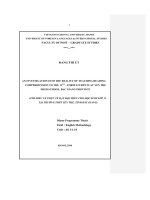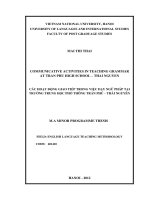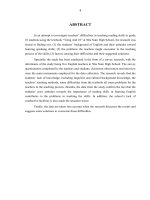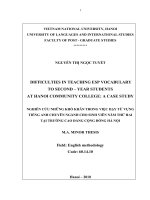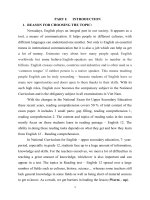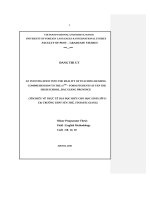Teachers' difficulties in teaching reading skills to grade 10th students at Nha Nam High school, Bacgiang province= Khó khăn của giáo viên trong việc dạy kỹ năn
Bạn đang xem bản rút gọn của tài liệu. Xem và tải ngay bản đầy đủ của tài liệu tại đây (1.16 MB, 61 trang )
4
ABSTRACT
In an attempt to investigate teachers’ difficulties in teaching reading skills to grade
10 students using the textbook “Tieng Anh 10” at Nha Nam High School, the research was
aimed at finding out: (1) the students’ background of English and their attitudes toward
learning speaking skills; (2) the problems the teachers might encounter in the teaching
process of the skills; (3) factors causing their difficulties and their suggested solutions.
Specially, the study has been conducted in the form of a survey research, with the
informants of the study being five English teachers at Nha Nam High School. The survey
questionnaire completed by the teachers and students, classroom observation and interview
were the main instruments employed for the data collection. The research reveals that the
students’ lack of knowledge, including linguistic and cultural background knowledge, the
teachers’ teaching methods, some difficulties from the textbook all cause problems for the
teachers in the teaching process. Besides, the data from the study confirm the fact that the
students’ poor attitudes towards the importance of reading skills in learning English
contributes to the problems in teaching the skills. In addition, the school’s lack of
conductive facilities is also made the situation worse.
Finally, the data are taken into account when the research discusses the results and
suggests some solutions to overcome those difficulties.
5
LIST OF TABLES AND FIGURES
Table 1: The results of classroom observations
Table 2: Teachers’ attitude towards reading skills
Table 3: Description of teachers’ opinions on the sections for reading in
textbook “Tieng Anh 10”.
Table 4: Teachers’ focus when teaching a reading text.
Table 5: Teachers’ perception of the students’ comprehension
Table 6: Description of teachers’ problems in teaching reading skills
Table 7: Description of the teachers’ solutions to deal with the difficulties
Table 8: Students’ attitudes towards reading skill
Table 9: Description of students’ opinions on the sections for reading in English 10
Table 10: Students’ focus when learning a reading text.
Table 11: Description of students’ problems in learning reading skills
Table 12: Students’ views of sources of difficulties.
Table 13: Students’ expectation of teachers’ solutions to their difficulties.
Chart 1: The way teachers ask their students to read the text.
Chart 2: Teachers’ expectation of the students in the post-reading
Chart 3: Students’ pre-reading activities.
Chart 4: Students’ while-reading activities
Chart 5: Factors affecting students’ comprehension of the text
Chart 6: Students’ expectation in the post-reading stage.
18
20
21
21
22
23
24
25
26
26
29
30
31
22
23
27
28
28
29
6
TABLE OF CONTENTS
PART I: INTRODUCTION 1
1. Rationale of the Study 1
2. Aims of the Study 2
3. Research Questions 2
4. Scope and Significance of the Study 2
5. Method of the Study 2
6. Organization of the Study 3
PART II: DEVELOPMENT 4
CHAPTER 1: LITERATURE REVIEW 4
1.1. The Nature of Reading 4
1.1.1. What is Reading and Reading Comprehension? 4
1.1.2. Effective Reading Comprehension and Reading Comprehension Skills 5
1.1.2.1. What is Effective Reading Comprehension? 5
1.1.2.2. Reading Comprehension Skills 6
1.2. Teaching Reading Comprehension 6
1.2.1. Relationship between Reading and Other Skills 6
1.2.2. The Roles of the Teacher and the Students in a Reading Lesson 7
1.2.2.1. The Roles of the Teacher 7
1.2.2.2. The Role of the Students 8
1.2.3. The Three Stages of a Reading Lesson 8
1.2.3.1. Pre-reading Stage 8
1.2.3.2. While-reading Stage 9
1.2.3.3. Post-reading Stage 9
1.3. Difficulties in Teaching Reading 9
1.3.1. Reading Skill Problems 10
1.3.2. Language Problems 10
1.3.3. Cultural Background Knowledge 11
CHAPTER 2: RESEARCH METHODOLOGY 12
2.1. The Current Situation of Teaching and Learning the Textbook at Nha Nam High
School 12
2.1.1 Introduction to Nha Nam High School and its Students 12
2.1.2. An Overview of the Textbook “Tieng Anh 10” 12
2.1.2.1. Objectives 13
2.1.2.2. Contents of the Textbook 13
7
2.1.3. Teachers and Methods of teaching 14
2.2. The Participants 14
2.3. Research Instruments 15
2.3.1. Questionnaire 15
2.3.2. Class Observation 15
2.3.3. Interview 16
2.4. Data Collection Procedure 16
CHAPTER 3: FINDINGS AND DISCUSSION 17
3.1. Presentation of Statistical Results 17
3.1.1. Classroom Observations and Interview 17
3.1.2. Questionnaire 19
3.1.2.1. Questionnaire for teachers 19
4.1.2.2. Questionnaire for students 24
3.2. Discussion of the Findings 32
3.2.1. Difficulties from Students 32
3.2.1.1. Students’ Attitudes towards Reading Skill 32
3.2.1.2. Students’ Lack of Knowledge 32
3.2.2. Difficulties from Teachers 33
3.2.3. Difficulties from the Textbook 34
CHAPTER 4: SOLUTIONS 35
4.1. Improving Students’ Reading Interest and Motivation 35
4.1.1. Making Reading Lessons Funny 35
4.1.2. Making Reading Skill Useful 35
4.2. Training Students to Become Efficient Readers 36
4.2.1. Making Students Aware of the nature of the reading process 36
4.2.2. Promoting Students with a Variety of Reading Strategies 36
4.3. Varying Reading Activities 37
4.4. Improving Teacher’s Classroom Techniques 37
4.5. Teachers’ Flexibility in Using the Textbook 38
4.6. Equipping Teaching Facilities 39
PART III: CONCLUSION 40
1. Summary of the Study 40
2. Limitations and Suggestions for Further Study 40
REFERENCES 42
APPENDIXES
1
PART I: INTRODUCTION
1. Rationale of the Study
English has experienced its popularity in Vietnam over the last few decades. The
demand for English even gets stronger when Vietnam fosters its international relations.
English, in parallel with the knowledge of some other fields, turns out to be a key to the
door into the bustling world. That is why English is now widely taught in almost all
education institutions, at every level.
At secondary schools, the teaching and learning of that international language has
been recently paid great attention to. When teaching English, the teacher teaches his
students not only the English language but also its usage. In the English textbook “Tieng
Anh 10”, reading is the first skill presented in each unit. This proves the important role of
reading. According to Carrell (1984:1), “for many students, reading is by far the most
important of the four skills in a second language, particularly in English as a second or
foreign language”. Unfortunately, teaching and learning reading skills at high schools is
still far from satisfaction. Despite the efforts of the teachers and students, the teachers often find
their students’ reading skills disappointing, which do not meet the requirements of the textbook.
At Nha Nam High School, where the author works, all of the English teachers have
the same problems. They have to confront some major obstacles in reading, such as:
students’ habits of word-by-word reading, excessive focus on details rather than main
ideas, poor vocabulary and limited background knowledge, etc. If those difficulties are not
found out and no solutions to overcome are given, it is certain that reading lessons can not
be successful and it even becomes worse.
In this situation, the teachers need to take a serious look at the teaching and
learning of English in general and the teaching and learning of the reading skills in
particular so as to suggest suitable techniques to enable the teaching and learning of the
reading comprehension at high school to be more effective. Being a teacher of English at
Nha Nam High School, the researcher wishes to give a hand in promoting reading skills for
her tenth-form students. This matter of fact has offered her a chance to conduct a study on
“Teachers’ difficulties in teaching reading skills to grade 10
th
students at Nha Nam
High School”. It is hoped that this study may offer the English teachers at schools in
general and the English techers at Nha Nam high school in particular the ways to teach
reading skills more effectively.
2
2. Aims of the Study
The main purpose of the study is to research on difficulties experienced by the
teachers of English at Nha Nam High School in teaching reading skills to grade tenth
students with the textbook “Tieng Anh 10”. And then some possible solutions are offered
to help the teachers overcome these difficulties so as to make an improvement in our
teaching and learning reading skills at high schools. The specific objectives of the study are:
● To investigate the students’ attitude towards speaking skills in their English learning.
● To examine the activities and techniques applied by the teachers at Nha Nam
high school
● To identify the teachers’ major difficulties in teaching reading skills and examine
the causes.
● To offer possible solutions to the difficulties.
3. Research Questions
The above aims of the study can be realized by the following research questions:
(i) What are the current methods and techniques of teaching reading skills used by
teachers at Nha Nam High School?
(ii) What are the difficulties experienced by teachers and students in teaching and
learning reading skills at Nha Nam High School?
(iii) What are the activities and techniques to be used to teach reading effectively at
Nha Nam High School?
4. Scope and Significance of the Study
This study is limited to:
- the 10
th
form students at Nha Nam High School;
- the teachers of English at Nha Nam High School; and
- reading comprehension in the textbook “Tieng Anh 10”.
The findings and suggested solutions most appropriately applied to the teachers of
English as well as 10
th
grade students at Nha Nam High School. That is, the teachers and
the students will be able to find ways to improve their process of teaching and learning
reading skills.
5. Method of the Study
The study was designed to use a number of methods to achieve its aims. Firstly,
classroom observation was carried out to investigate the reality of difficulties the teachers
3
confronted in their teaching reading skills. Then, two types of survey questionnaire were
conducted with informants of teachers of English and students randomly selected from 8
classes at Nha Nam High School. In addition to questionnaire, informal interviews with the
informants were also employed.
6. Organization of the Study
The study is organized as follows:
Part I, Introduction, presents the rationale for the study, the aims, research questions,
scope and significance, methodology and organization of the study.
Part II, Development, consists of the following chapters:
Chapter 1, Literature review, presents the theoretical background of reading skills.
Chapter 2, Looks at the current situations of teaching reading skills at Nha Nam High School.
Chapter 3, Research Methodology, focuses on the participants, the instruments and data
collection procedure.
Chapter 4, Discussion of the findings, discusses the data which was collected at the
second term of the 2010-2011 academic year at Nha Nam high School based on
questionnaire, classroom observations and interviews.
Chapter 5, Solutions, makes some pedagogical suggestions for teachers and students at
Nha Nam high School.
Part III, Conclusion, summarizes all the issues in the research and suggests some ideas
for further study.
4
PART II: DEVELOPMENT
CHAPTER 1: LITERATURE REVIEW
This chapter is aimed at providing a theoretical background to this study. The
review of issues most relevant to the focus of the study will be included: concepts of
reading and reading comprehension, reading process, reading difficulties for foreigner learners.
1.1. The Nature of Reading
1.1.1. What is Reading and Reading Comprehension?
Reading has been investigated by linguists, psychologists, educators and second
language researchers, but an exact definition of reading really causes much confusion
because different authors define the terms in different ways. Herein, I would like to
mention some definitions of reading extracted from different sources on the theme.
To give the definition, William (1984: 4), Nuttall (1996: 3), and Frank (1985:104)
share the same view that reading accounts for understanding what has been written. Also,
Goodman (1971 cited in Ha, 2003:6), states that: “reading is psycholinguistic process by
which the reader, language user, reconstructs, as best as he can, a message which has been
encoded by writer as a graphic display.”
Ur’s simple definition is “reading means reading and understanding” (Ur, 1996:
138). Harmer (1989: 190) seems to be interested in the notion of reading. He says “reading
is an exercise dominated by the eyes and the brain. The eyes receive message and the brain
then has to work out the significance of the message.”
Moreover, Rubin, and Thomson, (1994: 91) offers another definition of reading:
“Reading is an active information-seeking process in which readers relate information in
the text to what they already know”. From this point of view, the reader’s knowledge of the
knowledge and knowledge of the world is of importance to their reading success.
It is clear that no definition can possibly capture all the ideas and features of what
reading is. However, what they all share is that they try to find out the nature of reading,
and reading act, in which the readers, reading process, and reading message are emphasized.
Reading comprehension
In teaching reading, it is necessary to understand the nature of reading
comprehension. What the teacher understands about it will have a great influence on what
5
he or she teaches in the class. In fact, methodologists have been providing different
definitions of reading comprehension.
According to Grellet (1981: 3): “Reading comprehension or understanding a
written text means extracting the required information from it as efficiently as possible.”
The author means that reading comprehension is an activity which aims at decoding the
meaning of word combination in the text in the most efficient way.
Also concerning the reading comprehension, Richard and Good (1978: 9) provide a
clearer point of view:
“Reading comprehension is best described as an understanding between the author
and the reader. The emphasis is on the reader understanding of the printed page
based on the individual reader’s unique background of experience.”
So far we have looked at some definitions concerning reading and reading
comprehension which have been seen from different points of views. It is more significant
to have a more in-depth look at the reading process to make the bridge to the focus of the study.
1.1.2. Effective Reading Comprehension and Reading Comprehension Skills
1.1.2.1. What is Effective Reading Comprehension?
Ur (1996: 148) views reading comprehension as a process combining such elements as:
A clear purpose in mind; an enhanced motivation; appropriate reading comprehension
strategies based on the purposes and motivation; good prediction; sufficient background
information and vocabulary; close attention to the significant bits; and fairly high speed.
Cook (1989: 14), on the other hand, contends that effective reading comprehension
would be best reflected if we bring distinct cognitive behaviors of good versus poor readers
before, during and after reading an assignment into a comparison.
Stage
Good or mature readers
Poor or immature readers
Before reading
- Active prior knowledge
- Understand task and set
purpose
- Choose appropriate strategies
- Start reading without preparation
- Read without knowing why
- Read without considering how
to approach the material
During reading
- Focus attention
- Anticipate predict
- Use fix-up strategies when lack
- Are easily distracted
- Read to get done
- Do not know what to do when
6
of understanding occurs
- Use contextual analysis to
assist comprehension
- Self-monitor comprehension by
+ knowing comprehension is occurring
+ knowing what is understood
lack of comprehension occurs
- Do not recognize important vocabulary
- Do not see any organization
- Add on rather than integrate new
information
- Do not realize they do not understand
After reading
- Reflect on what was read
- Feel success is a result of effort
- Summarize major ideas
- Seek additional information
from outside sources
- Stop reading
- Feel success is a result of luck
1.1.2.2. Reading Comprehension Skills
Nutall (1982) provides a list of reading skills which consist of macro-skills with
word-attack skills and text-attack skills.
Word-attack skills are composed of processing morphological information,
distinguishing structural clues, inferencing (or guessing the meanings of unfamiliar words)
from context, active, receptive and throw-away vocabulary, learning to ignore difficult
words and using dictionary.
Text-attack skills include two subgroups:
Significance and cohesion: understanding sentence syntax, recognizing and
interpreting cohesive devices and interpreting discourse markers.
Discourse: recognizing functional value, recognizing the presuppositions underlying
the text, recognizing implications and marking inferences, and prediction.
1.2. Teaching Reading Comprehension
1.2.1. Relationship between Reading and Other Skills
In the process of teaching and learning English, it is very crucial for learners to
realize the integration of language. That is the possibilities of other aspects of foreign
program. Therefore, reading skill is closely related to writing, listening and speaking skills.
Understanding relations will help learners succeed.
Firstly, reading is related to writing. That is when the students are asked to
summarize or continue the reading material such as resume, descriptions of the characters, etc.
7
Secondly, reading is concerned with listening comprehension. Students may listen
to a story, a play…then read it or read first and “listening to a worthwhile reading or
dramatic presentation of what they have read.” (Rivers and Temperly, 1978: 259).
Thirdly, that is integration of reading and speaking. Reading materials serve as
fundamental source for oral presentations as they can base on these ideas they have read,
discuss or debate for their own purposes. This is the best way for them to share what they
have been reading with others.
To summarize, those combinations should be put into serious consideration when
teaching and learning English as a foreign language.
1.2.2. The Roles of the Teacher and the Students in a Reading Lesson
1.2.2.1. The Roles of the Teacher
So far there have been various approaches to teaching reading, such as the
traditional approach, process-based approach and task-based approach (Pham, 2005 cited
in Hoang et al., 1005: 517). In all these approaches, apart from the evident roles of learners
in the process of reading comprehension, the roles of teachers in an EFL reading lesson are
also significant and worth mentioning. Discussing the roles of the teacher in teaching
reading, Richard and Amato (1988) emphasize:
“The first role is to facilitate communicative process between all participants in the
classroom, and between these participants and the various activities and text. The
second role is to act interdependent within the learning teaching group.”
Being concerned with the roles of the teacher in teaching reading, Harmer (2001:
213) gives an opinion that the teacher needs to create interest in the topic and task. He also
needs to work as an organizer, observer, feedback organizer and prompter.
▪ An observer: While students are reading, the teacher can observe their progress
since it will give him valuable information about how well his students are doing
individually or collectively, and will tell him whether to give them extra time, or move to
organize feedback more quickly than he has anticipated.
▪ A feedback organizer: When the students have completed the given tasks. The
teacher can lead a feedback session to check if they have completed the tasks successfully or not.
▪ A prompter: When students are reading the text, it is also necessary to draw their
attention to the language features in that text. He may direct his students to certain features
of the text construction clarify ambiguities and make them aware of issues of the text
structure which they have not come across previously.
8
In general, the teacher must be aware of what they need to do in a reading lesson.
Playing their roles well will certainly helps the teacher lead successful reading lessons.
1.2.2.2. The Role of the Students
In communicative language teaching, the learners are regarded as the centre of the
lesson. It is true in every reading lesson. During the reading process the students play the
roles of an active and creative listener and as well as reader.
In a reading lesson, students must take an active role as a listener. They need listen
to the teacher’s instructions and explanation carefully to find out the way of recognizing
information and the way of deducing new words or grammatical structures.
The students must also be active and flexible readers, it is wise if they work on
their own during the reading process, make full use of the class time to read and do the
exercise to achieve a full understanding of the text. It is necessary for them to find out
suitable reading strategy and use their background knowledge to fulfill their tasks because
the significance of the text as well as the information is not always directly stated in printed pages.
In summary, teacher and students are interrelated to each other during the process
of teaching and learning reading skills.
1.2.3. The Three Stages of a Reading Lesson
Although the role of reading activities in teaching reading is made apparent, how
they are organized and sequenced in a lesson varies among different approaches to
language teaching. In the light of recent and widely accepted communicative approach, it
is a common practice that a reading lesson includes three stages: pre-, while- and post-
reading. (William, 1984; Dubin and Bycina, 1991 cited in To et al., 2006: 158) (Hoang et
al., 2005). Each stage is characterized by its own aims and procedures as follows.
1.2.3.1. Pre-reading Stage
In this early stage, teachers are expected to motivate students to read, specifically
by activating or building students’ background knowledge of the subject and familiarizing
them with some of the language needed in coping with the text. According to Williams
(1984: 37). The purposes of the pre-reading stage are:
- To introduce and arouse interest in the topic.
- To motivate learners by giving a reason for reading.
- To provide some language preparation for the text.
9
Normally, pre-reading phase often lasts from two to ten minutes depending on each
lesson. Several techniques, as suggested by To et al., (2006: 158) are: using pictures,
predicting from the titles, guessing and brainstorming to see what students have already know.
In general, in the pre-reading stage, it is necessary to get a good preparation for
students, provide them the sense of what they are going to do in their reading lesson.
1.2.3.2. While-reading Stage
While-reading stage is the main part of a reading lesson. Without this stage, the
students will lose the chance to deal with the text to understand the writer’s purpose and
clarify the text’s content in detail. William (1984: 38) points out the aims of the while-reading stage:
- To help understanding of the writer’s purpose.
- To help understanding of the text structure.
- To clarify text content.
The techniques applied in this stage widely vary, ranging from guessing new words
in contexts, asking questions to note-taking. Teachers, at the while-reading stage, need to
help their students comprehend the text thoroughly while students have to apply to the best
their reading skills like skimming, scanning, guessing, etc. to understand the text as well as
the writer’s purposes conveyed through the reading text. Apparently, time allocation for
this is nearly two thirds of the whole lesson.
1.2.3.3. Post-reading Stage
The post-reading stage is the final but not the less important stage of a reading
lesson because it is time for students to apply what they have got from the text into real life
communication. In other words, it is the time for students’ production. What they produce
will reflect how well they comprehend the text. In William’s view (1984: 39), “the post-
reading stage is aimed at consolidating or reflecting upon what has been said and relating
the text to the learners’ own knowledge, interests or views”. Normally, it takes ten or fifteen
minutes to complete all activities at this stage.
In conclusion, the above-mentioned stages are essential for a reading lesson.
However, it is not necessary to carry out all these stages mechanically on every occasion.
Depending on the purposes of each reading lesson, the teacher may apply these stages as
well as allocate time for each stage appropriately.
1.3. Difficulties in Teaching Reading
As being mentioned above, no one can deny the important role of reading skill.
However, it is uneasy for a language learner to be successful in learning reading because
10
there are many factors affecting the success such as reader’s reading habits, attitude,
motivation, exposure to the target language, textual characteristics, the way reading skill is
taught and the teacher’s classroom techniques or learning environment, etc. Jolly (1978),
Coady (1979) and others grouped those factors into three types: reading skill problem, language
problem, and cultural background knowledge.
1.3.1. Reading Skill Problems
According to Jolly (1987), Coady (1979) and others, one’s first language reading
ability plays a more important role in reading success than his level of the target language
does, because foreign language reading requires the transference of old skills, not the
learning of new ones. They believe that if the reader has a poor reading ability in his mother
tongue, then, he can not read well in a foreign language.
Students’ limited reading skills create many problems, such as reading slowly,
failing to understand and summarize main ideas of the reading text, unable to guess or
predict the meaning of the words or phrases used in that context, etc. Therefore, such
students find it hard to be successful in their reading. They cannot understand the text
thoroughly and those are the reasons why they do not want to keep on reading.
In addition, learner’s motivation towards reading is also an important factor in
reading process. It may affect on reading result such as good speed, enjoyment and
comprehension. Lack of motivation, the reader does not want to read any more.
1.3.2. Language Problems
Yorio (1971: 108) argues that reading problems of FL learners are due largely to
the imperfect knowledge of the target language and to mother tongue inference in the
reading process. Therefore, learners with limited knowledge of the target language might
have considerable difficulties when reading in the target language.
The first and foremost problem is that the readers may have to work with
unfamiliar and difficult topics. These are called “text problem”. The content of the text
might be rather strange to the students and the grammatical might be new. Therefore, they
can not understand it. The readers will find the text very challenging and might not have any
motivation left to keep on reading.
The second but not less important kind of problem is the “vocabulary problem”. As
everyone knows, grammatical knowledge accounts for a great deal of competence in
reading. However, knowledge of vocabulary is a great deal more important as a factor of
reading comprehension than awareness of grammatical structures (O’Donnel, 1961: 313-
11
316). Readers encounter a lot of difficulties in dealing with proverbs and idioms,
synonyms and antonyms, poly-semantic and sub-technical vocabulary. Metaphor,
metonymy and other types of transference of meaning also cause great difficulties for readers.
1.3.3. Cultural Background Knowledge
Apart from language problems and reading skill problems, cultural background
knowledge can also affect students’ ability as culture plays a central role for many topics.
And that comprehension of a culturally unfamiliar text is more difficult than
comprehension of a culturally familiar text, because readers, facing up with unfamiliar
context, may mistranslate or misinterpret the text according to their own cultural experience.
For the text structure, the impact of culture is less outwardly evident but apparently
still present. They will greatly affect the reader’s comprehension. Sometimes, the implicit
cultural knowledge presupposed by a text or from different assumption about meaning and
comprehension held by the writer also causes difficulty to the reader.
From what ahs been discussed, it can be concluded that there are three main factors
that affect reading comprehension: reading skills, language knowledge, and cultural
background knowledge. Reading difficulties may be caused by a number of other factors.
Whatever kind of problems they are, great efforts must be made to overcome them.
Summary
This chapter has been concerned with establishing the theoretical backgrounds and
issues relating to the topic of the study. First, it provides an overview of the nature of
reading, in which the definitions of reading and reading comprehension are discussed.
Then, teaching comprehension is addressed. Finally, it provides an insight into reading difficulties.
The next chapter will present the current situation of teaching and learning the
textbook at Nha Nam High School, where the data is collected.
12
CHAPTER 2: RESEARCH METHODOLOGY
2.1. The Current Situation of Teaching and Learning the Textbook at Nha Nam High
School
2.1.1 Introduction to Nha Nam High School and its Students
Nha Nam High School is located in Tan Yen district, Bac Giang province. This is a
small school. It has 24 classes. It has been in operation for only 10 years. The school is
surrounded by villages. Like other high schools, its duty is to train students from the 10
th
form to the 12
th
form.
The class size is generally large with 37-44 learners in one. The classrooms are
equipped only with a chalkboard and desks for two students sharing one. The school has
two projectors and computers which are occasionally used by teachers of all subjects in
teaching festivals. There is a library at school but there are not many books for reference.
Moreover, English newspapers and magazines, which are good sources of current target
language, are not available.
In our school, Math, Physics and Chemistry are chosen by most of the students who
wish to take the exams to colleges or universities. English is one of the compulsory
subjects at high school and in the school-leaving exam. However, few students choose the
colleges or universities which require an English exam.
The students at Nha Nam High School are approximately 16-18 years old. Lots of
them come from comparatively poor families so their learning condition is low. Their
parents can hardly afford to pay extra expenses for their children’s schooling such as a
dictionary, a cassette player or even some English reference books. Some of them do not
take care of their children.
Moreover, most of the students have low English level. The majority of them have
learned English four years, a few of them have learned it for seven years (three years at
primary school). However, their English background knowledge has remained a little. For
some students, the things they have learned at secondary school seem to be completely
new at the moment. They can not express their ideas even a very simple sentences.
In addition, their lack of awareness on the importance of English as well as
motivation makes them not interest in English. As a result, most of them do not have the
habit of learning independently and tend to depend on the textbooks and on the teacher for knowledge.
2.1.2. An Overview of the Textbook “Tieng Anh 10”
13
2.1.2.1. Objectives
The syllabus of the textbook “Tieng Anh 10” is the continuation of that of the
textbooks at secondary schools. Therefore, the objectives for the 10
th
form students to
achieve would be higher. By the end of the 10
th
form, students should be able to:
- Listen for the main ideas or for specific information of a monologue or a dialogue with
the length of 120-150 words of the topics they have learnt.
- Exchange information in English at a simple level about the situations relating to the
topics they have learnt.
- Comprehend passages of approximately 190-230 words about the topic s they have
learnt; Understand the main ideas of the text or understand the text in detail; Develop
vocabulary comprehension.
-Write paragraphs of about 100-120 words relating to the topics they have learnt according
to a model or with prompts.
2.1.2.2. Contents of the Textbook
The textbook “Tieng anh 10” is designed under a theme-based approach with 16
units. Each unit is about a theme. There are five parts in each unit arranged as follows:
Reading, Speaking, Listening, Writing, and Language Focus.
Reading is the beginning part of each unit. The aim of this is that through reading
and through developing reading skills such as skimming, scanning, etc. the students are
provided with language input. This can help them to be acquainted with the theme. From
then, the students can speak, listen and write about the things relating to the theme in the new parts.
2.1.2.3. Characteristics of Reading Passages and Reading Tasks in the Textbook
Characteristics of Reading Passages
A reading passage in the textbook “Tieng Anh 10” has 190-230 words in length.
Each passage is closely related to the theme of the unit. It is divided into small paragraphs.
Some passages are long and rather difficult for the students to understand, as there are a lot
of difficult new words and grammatical structures. It takes time to elicit them.
Characteristics of reading tasks
In each unit, three kinds of tasks are designed. Each task has its own aim.
- Task 1 helps the students to understand words or phrases in the passage.
- Task 2 helps the students to comprehend the content of the passage.
- Task 3 helps the students to have an overall understanding of the passage.
14
Normally, task 1 and 2 are complicated and they require more time to do. These
tasks themselves cause a lot of difficulties for students.
2.1.3. Teachers and Methods of teaching
Our school has got six English teachers, aged from 26 to 36. Three of them
graduated from the College of Foreign Language, Ha Noi, and three of them graduated
from Thai Nguyen University of Education. The oldest teacher has 12 years of teaching
experience and the youngest has got two years. Each teacher has to teach 12 periods a week. Each
has the responsibility to teach three periods in each class.
As far as the methodology is concerned, the teachers are aware of the new trend in
teaching method nowadays: Learner-centered approach. They try to give their students
independence in studying by asking them to work through the text or discuss subject
matters in groups or in pairs after giving them some instructions. However, not all of the
teachers can do that and the amount of time spent in such activities is not much.
Furthermore, most of the 10
th
form students can not do these themselves. Therefore, the
teachers often employ the traditional method of teaching in reading lessons. Most of the
time, the teachers play the key role in the classroom, being the main speakers working
through the text. The teachers explain new words, new structures, even give the answers to
some difficult exercises. Then the students are passive. And the success depends on how
flexible and adaptable the individual teacher is to respond to the requirement of the
teaching situation.
2.2. The Participants
The research was undertaken with the participation of 5 teachers (excluding the
researcher) and 199 students. The two types of questionnaire were prepared to get
information for the research. The first was administered to a sample of 5 teachers of
English, of which 1 was male and 4 were female. Of 5 teachers, three were teaching grade
10 at the time of delivering the questionnaire, one taught tenth graders the previous
academic year, and one did it two years ago. In general, all of them had experience in
teaching reading skills to tenth form learners with the textbook “Tieng Anh 10”.
There were 8 classes of grade ten at the time of studying. To have reliable
variables, more than half of the classes should be included in the survey. To be objective,
judgmental sampling was not possible because these classes were not at the same level. So,
the classes must be picked by random sampling. The 5 classes chosen were: 10A1, 10A2,
10A4, 10A6, 10A7 and the followings were the number of students of each class:
15
- Class 10A1: 43 students (24 males and 19 females)
- Class 10A2: 37 students (10 males and 27 females)
- Class 10A4: 40 students (21 males and 19 females)
- Class 10A6: 38 students (18 males and 20 females)
- Class 10A7: 41 students (17 males and 24 females)
2.3. Research Instruments
The procedure of data collection is the survey method employing self-administered
questionnaire for both teachers and students. Classroom observations were carried out to
investigate how teachers conducted a reading period, how the students worked in the
periods and difficulties encountered. Personal discussions with individual teachers would
have been more effective to find out the problems in teaching reading skills.
In short, three measurement instruments were developed for data collection: (1)
classroom observation, (2) questionnaire, (3) interview. Those appear in the appendixes.
2.3.1. Questionnaire
These two types of questionnaire included both closed and open-ended questions.
Questionnaire for teachers was written in English, while the one for students was written in
Vietnamese to make sure that the students properly understood the questions.
Questionnaire designed for teachers aimed at seeking information of work
experience, teachers’ attitudes towards the reading sections in the textbook English 10, and
the problems they confronted with in the process of teaching reading skills.
Questionnaire for students tended to survey on their perception about the importance of
reading skills in learning English as a compulsory subject at school, their evaluation of
their current speaking competence, and difficulties they encountered in learning reading skills.
2.3.2. Class Observation
The researcher carried out classroom observations by visiting 3 classes in reading
periods and recording all activities occurred in each class: the teacher’s presentation on the
reading lessons, the teacher’s questions and explanations, the students’ performance in
English. The observation checklists for reading class were made. The checklists included five criteria:
1. Teacher’s preparation
2. Teacher’s presentation
3. Teacher’s method
4. Teacher’s/ students’ personal characteristics
16
5. Teacher-student interaction
2.3.3. Interview
The interview, which were semi-structured, and 20-25 minutes in length each,
focused on the critical issues arising from the observed lessons as well as issues related to
teachers’ difficulties in teaching reading skills.
All the interviews were conducted in Vietnamese in order for the participants to
fully articulate their views without being constrained by the use of a second language.
They were then fully transcribed, translated and analyzed by the researcher to uncover the
emerging themes.
2.4. Data Collection Procedure
Data collecting methods used for the study comprised survey questionnaire,
classroom observations, and interviews.
Classroom observations were conducted for one lesson for each class in three
weeks for three teachers. Because the teachers were not comfortable with their lessons
being video- or audio- recorded, the researcher took extensive field notes of all the
observed events in the classroom. Each teacher was interviewed once on the last day of
classroom observation.
Then, based on the classroom observations, the questionnaire was designed for the
students and teachers.
It is noted that in order to make it easy in analyzing data, 199 students of the tenth
form were surveyed. In stead of randomly selecting the individual, the researcher randomly
selected the classes for investigation.
Totally 204 copies of the questionnaire were delivered to students and 5 teachers
and all of the copies were returned and respectively used for analysis.
17
CHAPTER 3: FINDINGS AND DISCUSSION
3.1. Presentation of Statistical Results
3.1.1. Classroom Observations and Interview
The observation sheet was adapted from Brown, 1994. The results of classroom
observations are summarized in the table below:
* Note: A: applicable NA: not applicable
Categories
Results (%)
Criteria
A
NA
I. Preparation
1. Class organization (well-prepared and well-organized)
66.7
33.3
2. Apparently and appropriately prepared-objectives of the lesson
66.7
33.3
II. Presentation
3. Language of instructions are clear and concise and students are able
to carry them on.
Comments: Teachers used much Vietnamese
33.3
66.7
4. Authentic materials are added
0
100
5. The lesson smooth, sequent, and logical
66.7
33.3
6. Material is presented at the students’ level of comprehension
33.3
66.7
III. Execution/ Methods
7. The teacher moves round the class and make eyes contact with students
66.7
33.3
8. Examples are used effectively
33.3
66.7
9. Textbook is used flexibly
33.3
66.7
10. Time amount is distributed appropriately to the stages of the lesson
33.3
66.7
IV. Personal characteristics
11. Patience in eliciting students’ responses
66.7
33.3
12. Clarity, tone and audibility of voice
66.7
33.3
18
13. Pronunciation, intonation, fluency are in appropriate and acceptable
use of language
33.3
66.7
V. Teacher-student interaction
14. Teacher is a facilitator
33.3
66.7
15. Students are attentive and involved
33.3
66.7
16. Students are active
33.3
66.7
17. Effective individual, pair, and group work
33.3
66.7
18. Teacher’s controlling
66.7
33.3
Table 1: The results of classroom observations
The classroom observation results reflected the reality of the difficulties that the
teachers encountered in teaching English reading skills.
Teachers’ Preparation
As shown in Table 1, in preparation, the majority of the teachers (66.7%) prepared
the lessons carefully. The same number of them had clear objectives of the lessons and
tried to reach those objectives through out the lessons.
Teachers’ Presentation
Most of the lessons (66.7%) went smoothly and logically and teachers had clear
and concise instructions because of good preparation for the lessons. However, the teachers
used much Vietnamese in instructing students to do the tasks. They usually translated the
requirements of the tasks presented in the textbook into Vietnamese. When being asked in
the interview, one of the teachers said: “I want to use English in all lessons and often try to
speak as much English in class as possible. But you know, the students in my school are at
low level of English, so they can not listen to it well. So I must use Vietnamese in class to
make sure that my students understand what I am saying.”
Teachers’ Method
The majority of them (66.7%) moved around the class while the activities were
taking place. Only one of them stood in front of the class waiting for students’ answers.
The same number of them failed to use examples and illustrations effectively. One-third of
them spent appropriate amount of time on each stage of the lessons. The others spent much
time on presentation but less on practice. One teacher said when being interviewed: “In the
19
textbook Tieng Anh 10, some of the passages are long, and some of the tasks are too
difficult for my students. Sometimes, I need two periods to complete a reading lesson.”
Teachers’ Characteristics
In all class observed, teacher – student interaction was problematic. The teachers’
taking time was too much whereas that of the students was limited. Teachers tended to
explain the tasks and did almost of everything for students. In other words, teachers
controlled and directed the class according to the lessons.
When the teachers asked questions in English, many students sat quietly,
pretending to concentrate on the book but they had no answer. It seemed that they did not
understand what teachers were saying. However, when the teachers translated the
questions into Vietnamese, more than half of the class were likely to understand and began
to discuss (mostly in Vietnamese) to find the responses. This showed that the students were
not able to understand the teachers much in English because it appeared that they had low
English proficiency.
Apart from this, most of the teachers (2 out of 3) failed to organize pair and group
work effectively. Students joined timidly and used their mother tongue most of the time
during the tasks. In addition, one or two students in each group were so dominated while
the rest kept silent, listening to and following others’ instructions. It was seen that the
students were of different levels of English. One teacher answered the question while being
interviewed: “Most of the students do not work effectively and often depend on others’ in
pair wok or group work, so I do not let them work in groups very often.”
Furthermore, the majority of students in the classes observed were passive. They
hardly asked questions, disagreed, or expressed their own ideas. The teachers found it
difficult to encourage the students’ participation.
In short, the findings collected from class observation were: Teachers’ overuse of
Vietnamese; limited use of authentic materials; students’ low English proficiency; infective
organization of group work; students’ passive learning; little encouragement to students’
participation. The findings in the class observations were used to designed questionnaire.
3.1.2. Questionnaire
3.1.2.1. Questionnaire for teachers
3.1.2.1.1. Methodology
20
To elicit a reply for the difficulties the teachers at Nha Nam High School
encountered in teaching reading skills to 10
th
graders and solutions to overcome those
difficulties, 13 closed and open-ended questions are formulated:
Questions 1, 2, 3 (part I) request the matter concerning the teachers’
education and work experience
Questions 1 and 2 (Part II) aim at finding out the teachers’ opinions on the
importance of reading skill and the sections for reading skills in the
textbook “Tieng Anh 10”.
Questions 3, 4, 5 relate to the way the teachers often do in a reading lesson.
Questions 6, 7, 8 aim at finding out the problems the teachers face in
reading teaching process with the textbook “Tieng Anh 10”.
Questions 9, 10 focus on teachers’ suggested solutions to difficult
situations they meet.
3.1.2.1.2. Results
Teachers’ Personal Information
Nha Nam high school has 5 teachers of English (excluding the author), aged from
26 to 36. Only one of them was male. Most of them do not have many years of teaching
experience, from 2 to 12 years. However, all have taught the new textbook syllabus for Grade 10.
Problems Teachers Often Faced in Teaching Reading Skills
Question 1:
Categories
Number of teachers
Percentage
The most important
4
80%
As important as other skills
1
20%
Not so important as other skills
0
0%
Table 2: Teachers’ attitudes towards reading skill
Table 2 showed the teachers’ attitudes towards reading skill in comparison with the
other skills. The majority (80%) of the teachers agreed that reading skill was the most
important for the students in the textbook “Tieng Anh 10”. Only one of them said that
reading skill was as important as the others. None of the teachers put other skills ahead of
reading.
21
Question 2:
Opinions
Teachers
Percentage
Easy-to-teach
0
0%
Interesting
4
80%
Difficult-to-teach
4
80%
Boring
1
20%
Too long
3
60%
Too short
0
0%
Table 3: Description of teachers’ opinions on the sections for reading in English 10
Most of the teachers thought that the sections for reading in English 10 were
interesting but difficult to teach (80%) and too long (60%). 20% of them found it boring
and no one thought that they were too short.
Question 3:
Categories
Number of teachers
Percentage
New words
5
100%
New grammatical structures
4
80%
Ideas in the reading texts
2
40%
Cultural knowledge
1
20%
All of the above
1
20%
Table 4: Teachers’ focus when teaching a reading text.
As can be seen from Table 4, when conveying the reading text to the students, all of
the teachers focused on new words and most of them paid attention to new grammatical
structures (80%) whereas cultural knowledge and ideas in the reading texts were paid very
little attention to. 20% of them focused on cultural knowledge and 40% focused on ideas in the reading texts.
Question 4:
This question was to find out the normal activities of the teachers in a reading
lesson. As the result suggested, in the pre-reading stage, the teachers often encouraged
their students to involve in some activities. 4 out of 5 teachers introduced the topic of the
reading text. All of them introduced new words appearing in the reading text. 2 out of 5

